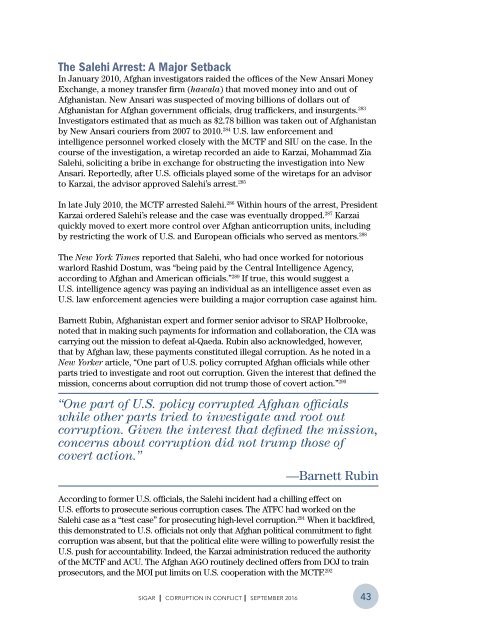CORRUPTION IN CONFLICT
5IlaWjQej
5IlaWjQej
Create successful ePaper yourself
Turn your PDF publications into a flip-book with our unique Google optimized e-Paper software.
The Salehi Arrest: A Major Setback<br />
In January 2010, Afghan investigators raided the offices of the New Ansari Money<br />
Exchange, a money transfer firm (hawala) that moved money into and out of<br />
Afghanistan. New Ansari was suspected of moving billions of dollars out of<br />
Afghanistan for Afghan government officials, drug traffickers, and insurgents. 283<br />
Investigators estimated that as much as $2.78 billion was taken out of Afghanistan<br />
by New Ansari couriers from 2007 to 2010. 284 U.S. law enforcement and<br />
intelligence personnel worked closely with the MCTF and SIU on the case. In the<br />
course of the investigation, a wiretap recorded an aide to Karzai, Mohammad Zia<br />
Salehi, soliciting a bribe in exchange for obstructing the investigation into New<br />
Ansari. Reportedly, after U.S. officials played some of the wiretaps for an advisor<br />
to Karzai, the advisor approved Salehi’s arrest. 285<br />
In late July 2010, the MCTF arrested Salehi. 286 Within hours of the arrest, President<br />
Karzai ordered Salehi’s release and the case was eventually dropped. 287 Karzai<br />
quickly moved to exert more control over Afghan anticorruption units, including<br />
by restricting the work of U.S. and European officials who served as mentors. 288<br />
The New York Times reported that Salehi, who had once worked for notorious<br />
warlord Rashid Dostum, was “being paid by the Central Intelligence Agency,<br />
according to Afghan and American officials.” 289 If true, this would suggest a<br />
U.S. intelligence agency was paying an individual as an intelligence asset even as<br />
U.S. law enforcement agencies were building a major corruption case against him.<br />
Barnett Rubin, Afghanistan expert and former senior advisor to SRAP Holbrooke,<br />
noted that in making such payments for information and collaboration, the CIA was<br />
carrying out the mission to defeat al-Qaeda. Rubin also acknowledged, however,<br />
that by Afghan law, these payments constituted illegal corruption. As he noted in a<br />
New Yorker article, “One part of U.S. policy corrupted Afghan officials while other<br />
parts tried to investigate and root out corruption. Given the interest that defined the<br />
mission, concerns about corruption did not trump those of covert action.” 290<br />
“One part of U.S. policy corrupted Afghan officials<br />
while other parts tried to investigate and root out<br />
corruption. Given the interest that defined the mission,<br />
concerns about corruption did not trump those of<br />
covert action.”<br />
—Barnett Rubin<br />
According to former U.S. officials, the Salehi incident had a chilling effect on<br />
U.S. efforts to prosecute serious corruption cases. The ATFC had worked on the<br />
Salehi case as a “test case” for prosecuting high-level corruption. 291 When it backfired,<br />
this demonstrated to U.S. officials not only that Afghan political commitment to fight<br />
corruption was absent, but that the political elite were willing to powerfully resist the<br />
U.S. push for accountability. Indeed, the Karzai administration reduced the authority<br />
of the MCTF and ACU. The Afghan AGO routinely declined offers from DOJ to train<br />
prosecutors, and the MOI put limits on U.S. cooperation with the MCTF. 292<br />
SIGAR I <strong>CORRUPTION</strong> <strong>IN</strong> <strong>CONFLICT</strong> I SEPTEMBER 2016<br />
43


